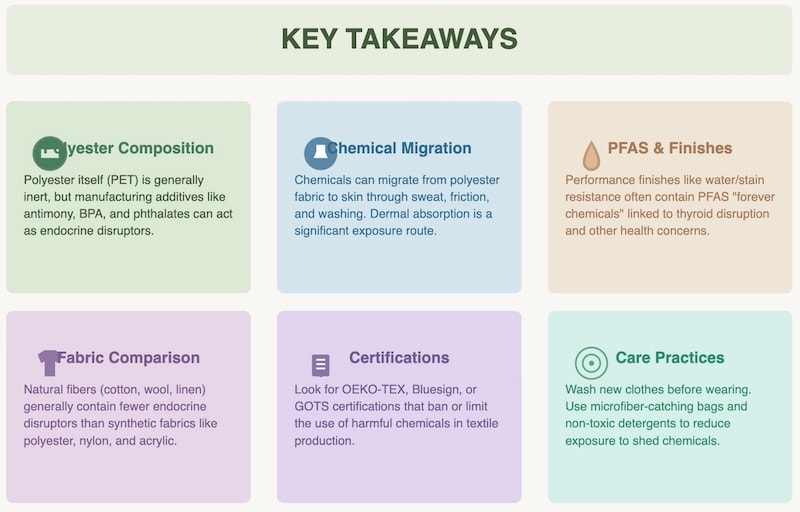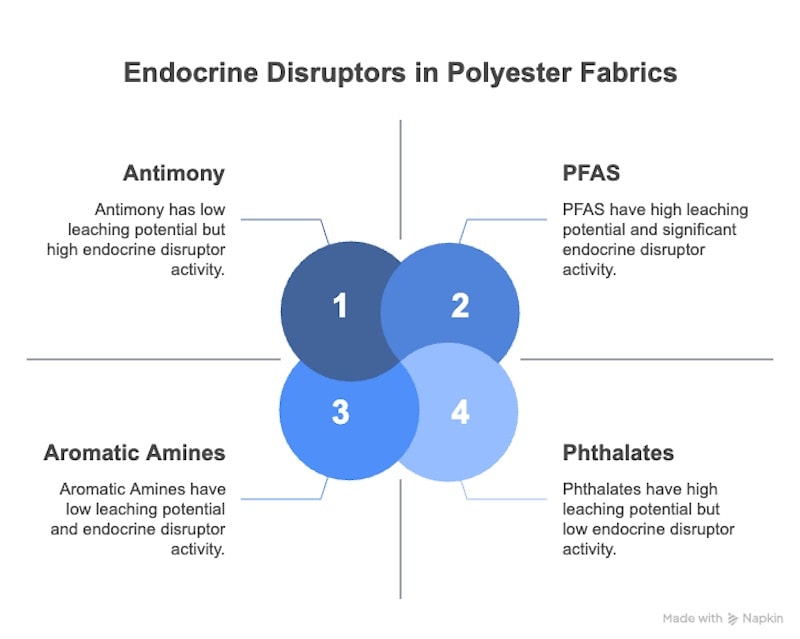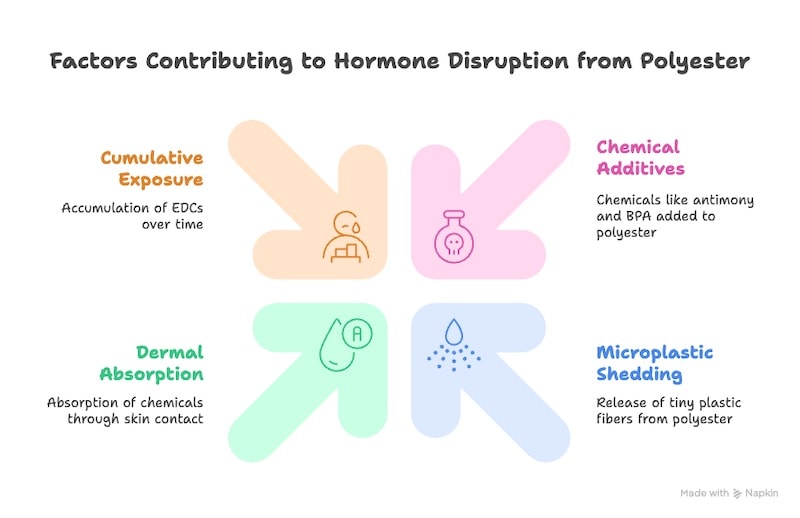Table of Contents
Chemikalien in Kleidung: Ist Polyester gesundheitsschädlich ?
This page may contain affiliate links. We may earn a commission on purchases, at no additional cost to you. Learn more →
Ist Polyester ein endokriner Disruptor? Diese Frage gewinnt zunehmend an Bedeutung, da Polyester—eines der weltweit am häufigsten verwendeten synthetischen Textilien, das etwa 70 % der synthetischen Fasern ausmacht—Chemikalien enthalten kann, die bekanntermaßen in das Hormonsystem eingreifen. Forschende haben Substanzen wie Bisphenol A (BPA), Phthalate und Antimon in Polyester dokumentiert. Dies wirft die Frage auf, wie genau diese Stoffe auf Mensch und Umwelt einwirken.
In diesem Beitrag schauen wir uns genauer an, wie Polyester hergestellt wird, welche Art von endokrinen Disruptoren es tragen kann und wie diese durch Hautkontakt, Schweiß oder beim Waschen möglicherweise in deinen Körper gelangen. Außerdem werfen wir einen Blick auf wissenschaftliche Studien und regulatorische Einblicke zum endokrin-disruptiven Potenzial von Polyester. Zu guter Letzt erhältst du einfache, praktische Tipps, wie du deine Gesundheit schützen und das Risiko verringern kannst, solchen Stoffen ausgesetzt zu sein.

Polyester 101: Mehr als nur ein „Plastikstoff“
Polyester besteht hauptsächlich aus Polyethylenterephthalat (PET), einem Kunststoff, der durch die Reaktion von Ethylenglykol mit Terephthalsäure entsteht. Das PET-Polymer selbst gilt im Labor meist als relativ reaktionsträge: Seine Grundbausteine aktivieren weder Östrogen- noch Androgen-Rezeptoren sehr stark. Doch das ist nur die halbe Geschichte von Polyester.
Das eigentliche Problem: Versteckte Zusatzstoffe
Während der Herstellung, Veredelung und Färbung können zahlreiche Zusatzstoffe ins Gewebe gelangen – und manche davon stehen im Verdacht oder sind bestätigt, endokrine Disruptoren (EDCs) zu sein.
1. Antimon: Der hartnäckige Katalysator
-
Warum es eingesetzt wird: Eine Antimon-Verbindung (Antimontrioxid) wird üblicherweise zur Katalyse der PET-Produktion verwendet. Ungefähr 80–85 % des neu hergestellten PETs werden damit produziert.
-
Hormonelle Aktivität: Laborstudien zeigen, dass 1 µM Antimontrichlorid in menschlichen Brustkrebszellen etwa 50–60 % der östrogenen Reaktion von 1 nM Estradiol auslösen kann.
-
Mögliches chemisches Auswaschen: Eine Studie von Leonard Sax (2010) brachte das Auslösen von Antimon aus PET in Verbindung mit östrogenartigen Effekten, die in abgefülltem Wasser beobachtet wurden.
Fazit: Obwohl Antimon im Faserverbund gebunden ist, kann es unter bestimmten Bedingungen migrieren und möglicherweise Östrogen imitieren.
2. Weichmacher & BPA: Schleichen sich über Beschichtungen ein
-
Phthalate: Obwohl Polyester in der Regel weniger Weichmacher benötigt als PVC, können Phthalate dennoch über Mischgewebe oder Textilveredelungen dazukommen. Eine kanadische Studie fand heraus, dass 20 % der Fast-Fashion-Kinderartikel Phthalate, Blei und PFAS über sicheren Grenzwerten enthielten. Diese Weichmacher sind bekannt dafür, in das Hormonsystem einzugreifen.
-
Bisphenol A (BPA): Ein synthetisches Östrogen, das unerwartet in Polyester-Spandex-Kleidung auftauchen kann. Tests zeigten, dass BPA-Konzentrationen bis zu 19-fach über der in Kalifornien geltenden Sicherheitsgrenze in manchen Socken und Sport-BHs lagen. In Deutschland und der EU regeln das Bundesinstitut für Risikobewertung (BfR) und die REACH-Verordnung Grenzwerte für BPA; allerdings sind auch hier Überschreitungen möglich. BPA kann leicht durch die Haut dringen, besonders wenn du schwitzt.
Wichtige Erkenntnis: Phthalate und BPA sind in Polyester nicht immer offensichtlich, können aber in bestimmten Farbstoffen, Beschichtungen oder Mischgeweben in kleinen Mengen vorkommen. Das tägliche Tragen kann so durchaus relevant sein.
3. Farbstoffe: Noch mehr chemische Schichten
Polyester wird oft mit Dispersionsfarbstoffen gefärbt, die für leuchtende, langanhaltende Farben bekannt sind. Allerdings gilt:
-
Benzothiazol (in manchen Farbstoffen/Veredelungen) wurde in Untersuchungen aus dem Stoff ausgewaschen; 62 % durchdrangen eine simulierte Hautmembran und 37 % wurden innerhalb von 24 Stunden absorbiert.
-
Aromatische Amine & Schwermetalle: Manche Farbstoffe enthalten Substanzen, die toxisch oder allergen wirken können; über ihre direkte hormonelle Wirkung ist weniger bekannt.
-
Realitätsbeispiel: Flugbegleiter-Uniformen aus „knallig gefärbtem Polyester“ enthielten neuartige falten- und fleckenresistente Chemikalien; das Kabinenpersonal klagte über Gesundheitsbeschwerden nach der Umstellung.
Merke: Farbstoffe können Chemikalien enthalten, die in die Haut eindringen und somit eine weitere Expositionsquelle für EDCs darstellen.
4. Veredelungen & Ausrüstungen: PFAS & andere Spezialbehandlungen
Polyester wird häufig mit speziellen Beschichtungen behandelt, um Wasserabweisung, Fleckenschutz oder antimikrobielle Eigenschaften zu erzielen:
-
PFAS („Ewigkeitschemikalien“): Eine Studie von 2022 ergab, dass 65 % der getesteten nordamerikanischen Schuluniformen (oft Polyester oder Poly-Mischungen) bedenkliche PFAS-Werte aufwiesen. 6:2 FTOH (ein PFAS-Vorläufer) war am häufigsten; Gesamt-PFAS lagen teils bei 153.000 ng/g (~153 ppm). PFAS-Exposition wird mit Schilddrüsenstörungen, Fortpflanzungsschäden, bestimmten Krebsarten und anderen immunologischen und Entwicklungsproblemen verknüpft.
-
Andere Ausrüstungen: Flammschutzmittel wie PBDEs können die Schilddrüsenfunktion stören; Triclosan beeinträchtigt Schilddrüsen- und Östrogensignalwege; auch antibakterielle Behandlungen (z. B. auf Silberbasis) stehen im Verdacht, das Hormonsystem zu beeinflussen.
Warum es wichtig ist: PFAS/Flammschutzmittel können mit der Zeit abblättern und so in Hausstaub, Abwasser und direkt auf deine Haut gelangen.

Beeinflusst Polyester Hormone?
Chemikalienmigration und Exposition durch Polyesterkleidung
Kurz gesagt: Ja, es kann sein. Polyester an sich wird zwar nicht offiziell als endokriner Disruptor eingestuft, ist aber häufig mit Zusätzen (Antimon, BPA, Phthalate, PFAS usw.) behaftet, die erwiesenermaßen oder zumindest verdächtig sind, Hormone zu stören.
-
Freisetzung von Mikroplastik: Beim Waschen oder Tragen von Polyester lösen sich winzige Plastikfasern, die Chemikalien binden. Dieses Mikroplastik taucht in Ozeanen, Trinkwasser und sogar menschlichem Gewebe auf.
-
Dermale Absorption: Kleidung liegt eng an der Haut, und künstliche Schweißtests zeigen, dass manche Schadstoffe aus Polyester ins Gewebe gelangen können, besonders bei Feuchtigkeit oder Reibung.
-
Kumulative Exposition: Mehrere geringfügige Chemikalienquellen summieren sich über Zeit. So kann sogar eine tägliche kleine Aufnahme von EDCs langfristig relevant werden.

Polyester vs. andere Stoffe
Es ist nicht die eigentliche Faserstruktur, sondern die damit verknüpften Chemikalien, die das Hormonsystem beeinträchtigen können. Synthetische Materialien (Polyester, Nylon, Acryl, Spandex) sind für hormonaktive Zusätze besonders anfällig. Zwar kann auch jede andere Kleidung EDC-haltige Farbstoffe oder Ausrüstungen enthalten, aber Polyester fällt durch petrochemische Herstellungsprozesse und Veredelungen oft negativ auf.
Naturfasern wie Baumwolle, Wolle, Seide, Hanf oder Leinen sind hingegen in ihrem Rohzustand seltener mit Hormonschadstoffen belastet (abgesehen von Pestiziden oder Farbstoffen). Ein Baumwollshirt enthält zum Beispiel kein Plastik und somit typischerweise kein BPA. Für gesundheits- oder umweltbewusste Menschen empfehlen Expert:innen daher häufig, nach Möglichkeit auf unbehandelte Naturfasern zu setzen.

Marketingbegriffe wie „feuchtigkeitsableitend“, „schnelltrocknend“ oder „stain-proof“ verweisen oft auf chemische Behandlungen, die potenziell hormonaktive Substanzen (z. B. PFAS oder BPA) enthalten. Das heißt nicht, dass du nie wieder Polyester-Leggings tragen darfst. Doch wer besonders vorsichtig sein möchte—beispielsweise bei Kinderkleidung—kann den Anteil synthetischer Stoffe im Kleiderschrank reduzieren oder zumindest weniger häufig und nicht zu lange am Stück tragen.
Welche Produkte haben besonders viele endokrine Disruptoren?
Leider finden sich hormonstörende Chemikalien nicht nur in Kleidung, sondern überall in unserem Alltag. Folgende Produktgruppen sind besonders im Fokus:
-
Plastikbehälter & Konservendosen: Enthalten oft BPA (oder Bisphenol-Analoge), das bei Erhitzung oder längerem Kontakt in Lebensmittel übergehen kann.
-
Pflege- & Kosmetikprodukte: Begriffe wie „parabenfrei“ oder „phthalatfrei“ sind wichtig, denn Parabene und Phthalate stören hormonelle Prozesse und können durch die Haut aufgenommen werden.
-
Haushaltsprodukte & Inneneinrichtung: Vinyl-Spielzeug, Duschvorhänge oder Kunstledermöbel enthalten häufig Phthalate; ältere Möbel sind teils mit Flammschutzmitteln (PBDEs) behandelt.
-
Kassenbons/Thermopapier: Oft mit BPA oder BPS beschichtet; Kontakt kann diese Stoffe auf die Haut übertragen.
-
Antihaft-Kochgeschirr & wasserabweisende Ausrüstung: Teflonpfannen und Outdoor-Kleidung werden häufig mit PFAS versehen, die z. B. Schilddrüsenfunktionen beeinträchtigen können.

Chemikalienquellen addieren sich. Deshalb raten Expert:innen, mehrere kleine Verbesserungen zu machen. Glaskonservierung statt Plastik, natürliche Kosmetik, Naturfasern in der Kleidung etc. können die Gesamtbelastung senken.
Praktische Tipps für deinen Alltag
Die Idee, dass Kleidung deine Hormone beeinträchtigen könnte, wirkt beunruhigend. Doch mit ein paar einfachen Tricks kannst du dein Risiko deutlich senken:
-
Setze auf natürliche, ökologische Fasern: Bio-Baumwolle, Bambus, Hanf, Wolle oder Seide – am besten zertifiziert (z. B. GOTS, OEKO-TEX).
-
Zertifizierungen: OEKO-TEX Standard 100, Bluesign oder GOTS verbieten oder beschränken kritische Chemikalien (z. B. PFAS, Flammschutzmittel).
-
Veredelte-Kleidung bewusst wählen: Outdoor-Labels bieten teils PFAS-freie Alternativen. Achte auf Begriffe wie „non-toxic Activewear“ oder „Eco-Finish“.
-
Kleidung vor dem Tragen waschen und lüften: So entfernst du oberflächliche Chemikalien (z. B. Farbstoffreste) und reduzierst Ausdünstungen.
-
Mikroplastik-Filter oder Waschbeutel: Reduziere das Freisetzen von Mikrofasern, etwa mit dem „Guppyfriend“-Beutel. Das hilft deiner Gesundheit und der Umwelt.
-
Vorsicht bei „Anti“ oder „Pro“-Marketing: „Fleckenabweisend“, „knitterfrei“, „antimikrobiell“, „anti-odor“ – das sind oft Codewörter für chemische Zusätze. Wenn du es nicht wirklich brauchst, lieber drauf verzichten.
Wichtig ist, sich nicht verrückt zu machen. Stress schadet ebenfalls dem Hormonsystem. Wer informiert ist, kann Schritt für Schritt synthetische Artikel in der Garderobe reduzieren oder sich für weniger belastete Alternativen entscheiden.
Wichtigste Erkenntnisse
-
Polyester-Zusätze: Antimon, BPA, Phthalate und PFAS können bei der Herstellung und Veredelung ins Gewebe gelangen.
-
Hormonstörungen: Diese Chemikalien wirken als endokrine Disruptoren und können das Wachstum, die Fortpflanzung und den Stoffwechsel beeinflussen.
-
Expositionswege: Hautkontakt (besonders mit Schweiß/Reibung), das Einatmen von Mikrofasern und Waschwasser sind relevante Pfade.
-
Sichere Alternativen: Naturfasern oder zertifizierte synthetische Stoffe (PFAS-frei) verringern das Risiko deutlich.
-
Praktische Schritte: Neue Kleidung waschen, Mikroplastik-Beutel nutzen, auf Labels achten und „High-Tech“-Finishes nur wählen, wenn wirklich nötig.
Ist Polyester gesundheitsschädlich bzw. ein endokriner Disruptor?
Polyester selbst—hergestellt aus PET—ist nicht automatisch ein hormonaktives Material. Allerdings kann der Cocktail an Chemikalien (Antimon, Weichmacher, PFAS usw.) im oder auf Polyester durchaus hormonelle Effekte haben. Diese Chemikalien können in Hautkontakt geraten, ins Abwasser oder in den Hausstaub gelangen. Wer möglichst wenig hormonaktiver Belastung durch Kleidung ausgesetzt sein möchte, greift besser zu Naturfasern (Baumwolle, Wolle, Leinen etc.) ohne Spezialausrüstung oder achtet auf zertifizierte Polyesterprodukte. Waschen hilft zwar, oberflächliche Schadstoffe zu reduzieren, aber eingebettete Stoffe (z. B. Antimon im Faserkern) bleiben bestehen. Mit dem entsprechenden Bewusstsein und etwas Recherche kann man das eigene Risiko signifikant vermindern.

FAQ zu Polyester und endokrinen Disruptoren
Enthält Polyester PFAS?
Das reine Polyester-Polymer (PET) enthält von Natur aus kein PFAS. Allerdings werden viele Polyesterprodukte – insbesondere Outdoor- und Sportbekleidung – mit PFAS beschichtet, um sie wasser- und schmutzabweisend zu machen.
Ist Polyester PFAS-frei?
Unbehandeltes Polyester ist im Ausgangszustand PFAS-frei. Sobald es jedoch mit wasser- oder fleckenabweisenden Finishes behandelt wird, können PFAS ins Spiel kommen. Wer sicher sein will, achtet auf Labels wie „PFAS-frei“ oder Zertifizierungen (z. B. OEKO-TEX, GOTS), die solche Chemikalien verbieten oder stark einschränken.
Warum ist Polyester schädlich?
Polyester selbst ist nicht automatisch gesundheitsschädlich, aber die bei der Herstellung und Veredelung eingesetzten Chemikalien wie Antimon, BPA, Phthalate und PFAS können als endokrine Disruptoren wirken, die den Hormonhaushalt stören. Diese Substanzen können durch Hautkontakt (besonders beim Schwitzen), Einatmen von Mikrofasern oder über das Waschwasser in den Körper gelangen und langfristig zu Hormonstörungen führen, weshalb besonders Sportbekleidung und Trainingskleidung aus Polyester problematisch sein können.
Welche Lebensmittel enthalten endokrine Disruptoren?
Im Artikel werden keine spezifischen Lebensmittel mit endokrinen Disruptoren genannt, aber es wird erwähnt, dass Plastikbehälter und Konservendosen oft BPA oder Bisphenol-Analoge enthalten, die bei Erhitzung oder längerem Kontakt in Lebensmittel übergehen können. Außerdem wird Antihaft-Kochgeschirr als Quelle von PFAS genannt, das bei der Zubereitung von Lebensmitteln auf diese übertragen werden kann.
Welche Kunststoffe sind endokrine Disruptoren?
Gängige Kunststoffe wie Polycarbonat (mit BPA) oder PVC (mit Phthalaten) können das Hormonsystem stören. Polystyrol (Styrol) sowie Kunststoffe mit Flammschutzmitteln (z. B. PBDEs) haben ähnliche Effekte. Diese Chemikalien können bei Wärme, UV-Strahlung oder Kontakt mit Säuren austreten.
Wo stecken überall Hormone drin?
Endokrine Disruptoren (künstliche Hormone) finden sich nicht nur in Polyester und anderen synthetischen Textilien, sondern auch in Plastikbehältern, Konservendosen mit BPA-Beschichtung, Kosmetika (mit Parabenen und Phthalaten), Haushalts- und Einrichtungsprodukten wie Vinyl-Spielzeug oder Kunstledermöbeln, Kassenbons (Thermopapier) sowie in Antihaft-Kochgeschirr und wasserabweisender Kleidung durch PFAS. Die Gesamtbelastung ergibt sich durch die Addition all dieser Chemikalienquellen aus unserem Alltag.
2 Kommentare
Excellent and thorough article – thank you for this. I only wish this article could be more mainstream …. that way people would not buy some of these ex-toxic items/clothing, and then maybe industry would make some healthier changes.
Thank You Lilija for sharing these important insights for health security. We are inundated with more chemicals all the time with little or no information for health concerns. Our children certainly deserve better!













